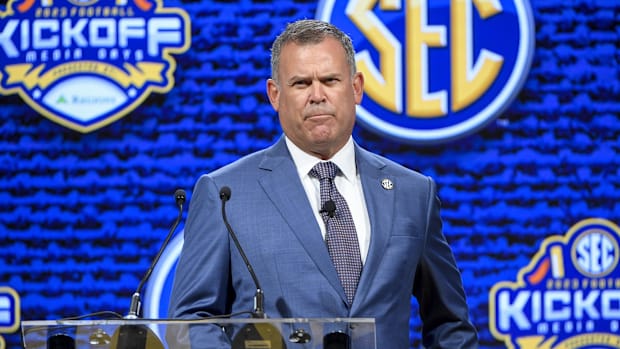
ATLANTA — College football is seeing a few minor rule changes this year, particularly involving play at the line of scrimmage.
In recent seasons, defensive line coaches across the country have increasingly exploited shifting protection gaps. However, the real issue prompting a rule adjustment isn’t the shifts themselves — it’s the simulated movement by defensive linemen that’s caused concern and led to the new regulation.
“We’ve seen a noticeable increase in defensive activity before the snap,” SEC coordinator of officials John McDaid said Tuesday. “There’s been a lot of abrupt, coordinated movement by defenses.
“Over the past four or five years, false starts have risen steadily, and I believe much of that is due to what defenses are doing pre-snap. This isn’t just an issue in the SEC — my colleagues and I are seeing the same trend nationwide.”

Arkansas fans will no doubt recall the Razorbacks’ struggles handling defensive shifts and stunts in key matchups against Georgia in 2021 and Liberty in 2022. In those two games alone, Arkansas allowed seven sacks, 21.5 tackles for loss, and was flagged for eight procedural penalties.
The disruptive pre-snap movement played a major role in a 37-0 shutout loss to Georgia and a stunning home upset by Liberty. However, Arkansas showed improvement in 2024 under new offensive line coach Eric Mateos, despite still surrendering 36 sacks on the season. Many of those came early in the year and were tied to unforced errors, particularly during quarterback Taylen Green’s scrambles.
Now, the NCAA is addressing these types of defensive tactics with a new rule aimed at balancing pre-snap responsibilities between both sides of the ball.
“This year, a change in the football rules is that we’re adding a standard to the defensive side of the ball that the offense has had for over a century,” said SEC coordinator of officials John McDaid. “The definition of a false start has always included any action that simulates the snap. That standard now applies to the defense as well, and officials will be judging defensive movement with that in mind.”
The change targets deceptive pre-snap motions designed to draw offensive linemen into committing false starts. For example, in a play shown on video during McDaid’s explanation, two defenders on the left legally executed a maneuver known as “stemming” — shifting position before the snap. However, a lineman on the right side of the defense made a sudden flinch that simulated the snap, prompting the right guard to move early, resulting in a penalty.
“That movement by the defenders on the left was legal,” McDaid explained. “But you’ll see the lineman between the right guard and right tackle flinch — he’s simulating the snap, and it works. It causes the right guard to jump.
“This kind of action is now clearly addressed in the rules. It’s considered delay of game on the defense — not a false start on the offense. The defense can’t simulate the snap in order to bait the offense into moving early.”

Leave a Reply